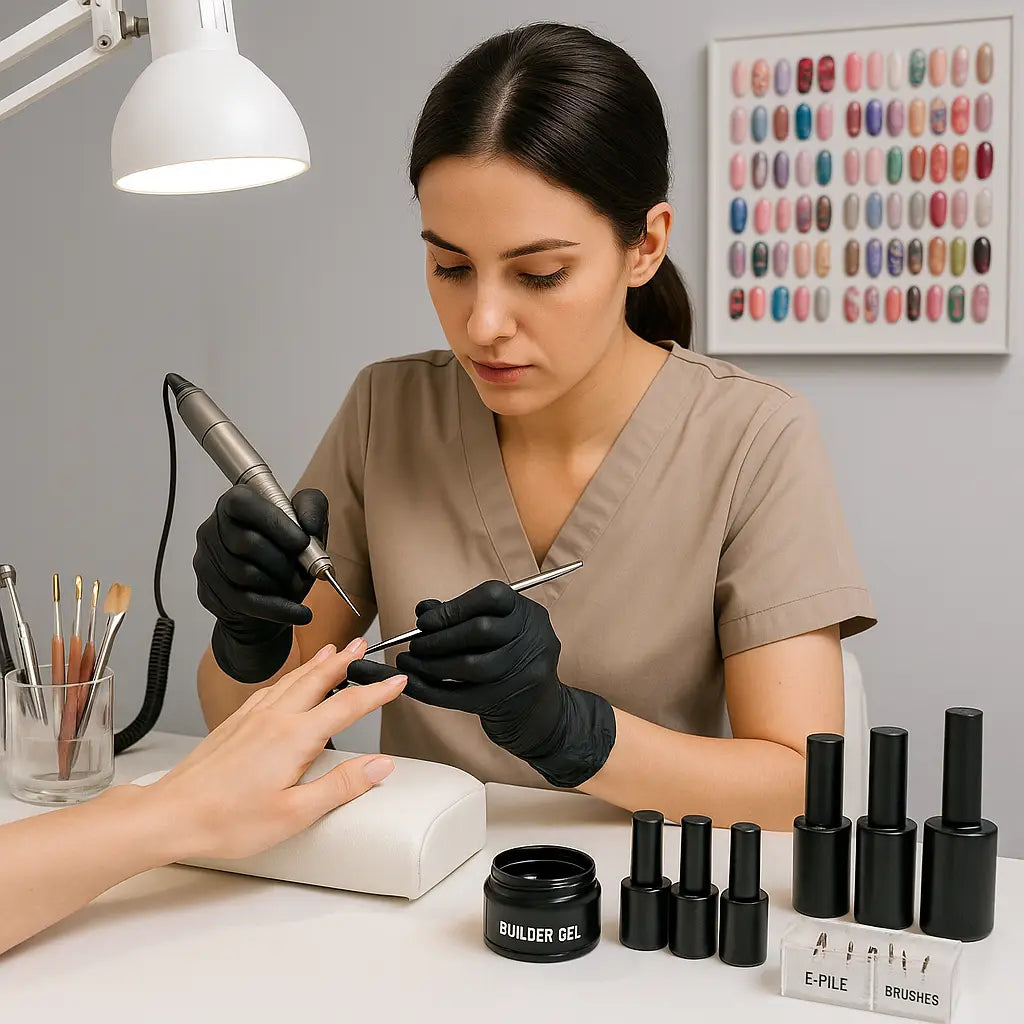How to Become a even more Efficient Nail Technician

Smart Techniques, Tools & Habits
Success in the nail industry is not just about talent—efficiency plays a critical role in increasing client satisfaction, maintaining a professional reputation, and growing your business. In today’s fast-paced salon environment, clients expect excellent results in a reasonable amount of time, and nail technicians must balance speed with precision and creativity.
Whether you are a beginner or an experienced professional, here are proven ways to boost your efficiency as a nail technician without compromising quality.
1. Master Your Techniques: Practice with Purpose
Efficiency starts with skill mastery. Learning and refining your techniques is the foundation of working faster while maintaining excellent results. Instead of rushing through services, take the time to improve:
- Cuticle work: Master using e-file bits or cuticle scissors to make prep seamless and clean.
- Gel application: Train your control and brush pressure to reduce the need for excessive filing.
- Nail shaping: Develop consistent movements and use reference points to minimize reshaping after product application.
Make practice intentional. Focus on a single area per session—whether it’s building the perfect apex or drawing a crisp French line—and use repetition to build muscle memory.
Pro Tip: Record yourself performing services and review your posture, movements, and tool usage. You’ll identify unnecessary motions or hesitations that you can eliminate.
2. Learn Specialized Techniques That Save Time
Efficiency also means knowing what techniques can simplify your workflow. For example:
- Russian Manicure: Though it takes time to master, it allows for cleaner cuticle work that reduces product lifting and increases longevity—resulting in fewer client complaints and rework.
- Flash curing techniques: When applying gel tips or builder gel, flash curing under a small LED lamp allows you to quickly secure the nail and move to the next.
- One-stroke designs or stamping: These can be used to create detailed nail art faster than hand painting each element.
Attend workshops or online courses regularly to stay updated with techniques that are not just trendy but designed to optimize time.
3. Use the Right Tools for the Job
Having the correct and high-quality tools can drastically change how efficiently you work.
For example:
- A French brush or angled liner brush helps you draw precise French lines in a single stroke.
- A Correction Stick can help clean the sidewalls and cuticle line during gel application, minimizing cleanup afterward.
- High-quality e-file bits (ceramic or carbide) stay sharp longer and reduce heat, allowing for faster and more comfortable removals.
Investing in the right tools saves time in both the short and long term. Cheap brushes with fraying bristles or dull drill bits can double your working time and reduce the quality of your results.
Efficiency tip: Organize your tools into kits based on service types—gel overlays, removals, nail art—so you don’t waste time gathering them for each client.
4. Know the Tools That Exist: Stay Informed
Many nail technicians are not aware of the full range of tools available to them.
For example:
- Specialized brushes: ombre brushes, petal brushes, dotting tools, French Brushes.
- Forms: pre-shaped nail forms for structure gels save time over custom-cutting each one.
- Lightweight cordless e-files: make it easier to move between workstations or perform mobile services.
Stay connected with distributors, follow manufacturers on social media, and watch reviews from trusted nail educators. You’ll often discover tools or products designed specifically to reduce application time or improve precision.
5. Organize Your Workspace
A cluttered workspace leads to time wasted searching for tools or products. A well-organized nail station allows for smooth transitions between steps and faster services.
Key organizational strategies:
- Use labeled drawers and containers for brushes, files, bits, and forms.
- Keep frequently used items (cleanser, top coat, base gel) within immediate reach.
- Have a clean, designated area for used tools to avoid cross-contamination and confusion.
Daily habit: Spend 5–10 minutes at the start and end of your workday organizing, sanitizing, and resetting your workstation.
An efficient setup doesn’t just save time—it also improves your posture and comfort, which prevents fatigue over long working hours.
6. Prepare in Advance for Each Client
Preparation before the appointment dramatically increases your speed during the session.
This includes:
- Pre-selecting nail tips or forms based on the client’s length and shape preference.
- Laying out products that you know will be used (e.g., swatch sticks of the colors they love).
- Having a client card with notes on past preferences, allergies, usual designs, and medical info.
Even better: Prepare swatch cards grouped by color themes or seasonal collections, so clients choose faster. Clients often take a long time deciding on colors—help them by narrowing the options visually. You might want to create examples for the month with nail art.
This is especially powerful when you’re booked back-to-back and need to avoid delays.
7. Know Your Products Inside and Out
Product familiarity leads to confidence and efficient product selection. For example:
- Know which base gels self-level quickly and reduce filing time.
- Understand the viscosity of your builder gels to avoid over-application.
- Be aware of cure times—some top coats are no-wipe and save an entire step.
There are also specialty products that offer time-saving benefits. For example, the base color gels from RIPOSO allow technicians to create a sheer base or milky color and structure in a single step—saving time compared to using a base coat followed by builder and then color.
Knowing what you use—and why you use it—gives you full control over timing and results.
8. Use Client Feedback and Track Service Timing
If you want to improve your timing, you have to track your services. Use a timer to monitor:
- Nail prep duration
- Application time
- Curing and art
Reviewing this helps identify bottlenecks (e.g., too much time spent on shaping or color correction). You can then revisit your technique or find tools/products to improve.
Additionally, ask clients for feedback—especially repeat clients. Were they comfortable during the service? Did any nails lift? Was the design what they expected?
Feedback helps you fine-tune your technique, product choices, and communication, which all contribute to efficiency.
9. Establish a Flow and Reduce Downtime
Set a repeatable flow for each type of service and stick to it. For example:
- Nail disinfection
- Cuticle prep
- Shaping
- Application (base, builder, color, top)
- Cleanup and oil
The more consistent your workflow, the more intuitive your timing becomes. You’ll automatically adjust based on nail type and design complexity—saving time without needing to think through each step.
Also: Limit distractions like chatting during curing, checking your phone, or stopping to search for products mid-session.
10. Efficiency ≠ Rushing
Lastly, efficiency is about being deliberate, not fast. Rushing leads to mistakes, poor application, and client dissatisfaction. True efficiency comes from:
- Reducing unnecessary steps
- Preventing rework
- Using tools and products that are right for your style
- Continuously learning and reflecting on your practice
Final Thoughts
Becoming a more efficient nail technician is a continual process of learning, organizing, and adapting. By combining smart product choices, intentional practice, and thoughtful preparation, you can work faster and more comfortably—while delivering consistent, high-quality results that your clients will appreciate.
Efficiency is not about doing more—it’s about doing better, faster, with confidence.
